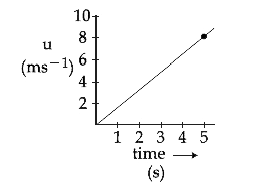A particle starts its SHM from mean position at t=0. If its time period is T and amplitude A then the distance travelled by the particle in the time from t=0→t=5TA is
A
3A
4A
5A
The correct Answer is:D
To find the distance traveled by a particle executing Simple Harmonic Motion (SHM) from time t=0 to t=5T4, we can follow these steps:
Step 1: Understand the Motion
The particle starts from the mean position at t=0. In SHM, the particle moves back and forth between the maximum amplitude A and the mean position. The time period of the motion is T.
Step 2: Determine the Motion in One Complete Cycle
In one complete cycle (time T), the particle travels from the mean position to the maximum amplitude A, back to the mean position, to the negative amplitude −A, and back to the mean position. The total distance traveled in one complete cycle is:
Distance in one cycle=A+A+A+A=4A
Step 3: Calculate the Distance for t=0 to t=T
From t=0 to t=T, the particle travels the entire distance of one complete cycle, which is 4A.
Step 4: Calculate the Distance for t=T to t=5T4
Now, we need to find the distance traveled from t=T to t=5T4. The time interval from T to 5T4 is:
Δt=5T4−T=5T4−4T4=T4
In this time interval Δt=T4, the particle will move from the mean position to the maximum amplitude A and then back to the mean position.
Step 5: Calculate the Distance in the Interval Δt
During this interval of T4, the particle travels:
- From the mean position (0) to the amplitude A (distance A)
- Back to the mean position (distance A)
Thus, the total distance traveled during this interval is:
Distance=A+A=2A
Step 6: Total Distance Traveled
Now, we can sum up the distances traveled:
- Distance from t=0 to t=T: 4A
- Distance from t=T to t=5T4: 2A
Therefore, the total distance traveled by the particle from t=0 to t=5T4 is:
Total Distance=4A+2A=6A
Final Answer
The distance traveled by the particle in the time from t=0 to t=5T4 is 6A.
---
The particle starts from the mean position at t=0. In SHM, the particle moves back and forth between the maximum amplitude A and the mean position. The time period of the motion is T.
In one complete cycle (time T), the particle travels from the mean position to the maximum amplitude A, back to the mean position, to the negative amplitude −A, and back to the mean position. The total distance traveled in one complete cycle is:
Distance in one cycle=A+A+A+A=4A
From t=0 to t=T, the particle travels the entire distance of one complete cycle, which is 4A.
Now, we need to find the distance traveled from t=T to t=5T4. The time interval from T to 5T4 is:
Δt=5T4−T=5T4−4T4=T4
During this interval of T4, the particle travels:
- From the mean position (0) to the amplitude A (distance A)
- Back to the mean position (distance A)
Distance=A+A=2A
Now, we can sum up the distances traveled:
- Distance from t=0 to t=T: 4A
- Distance from t=T to t=5T4: 2A
Total Distance=4A+2A=6A
The distance traveled by the particle in the time from t=0 to t=5T4 is 6A.
Topper's Solved these Questions
- OSCILLATIONSBOOK - NARAYNACHAPTER - OSCILLATIONSEXERCISE - VELOCITY AND ACCELERATION
10 Videos
- OSCILLATIONSBOOK - NARAYNACHAPTER - OSCILLATIONSEXERCISE - ENERGY OF A PARTICLE EXECUTING SHM
9 Videos
- OSCILLATIONSBOOK - NARAYNACHAPTER - OSCILLATIONSEXERCISE - LEVEL-I (H.W)
1 Video
- NEWTONS LAWS OF MOTIONBOOK - NARAYNACHAPTER - NEWTONS LAWS OF MOTIONEXERCISE - PASSAGE TYPE QUESTION
6 Videos
- PHYSICAL WORLDBOOK - NARAYNACHAPTER - PHYSICAL WORLDEXERCISE - C.U.Q
10 Videos
Similar Questions
Knowledge Check
In Q.118, total distance travelled by the particle from t=0 to t=t0 is:
AA02αBA0αC2A0αD4A0αA particle starts SHM from the mean position. Its amplitude is A and time period is T. At the time when its speed is half of the maximum speed, its displacement y is
AA2BA√2CA√32D2A√3A particle executes SHM of amplitude A and time period T The distance travelled by the particle in the during its phasde changes from π12 to 5π12 sin15=0.26,sin75=0.96
A1√2AB√32AC2√3AD√23A
The magnitude of displacement (in meters) by the particle from time t = 0 to t = t will be –
View SolutionThe speed verses time graph for a particle is shown in the figure. The distance travelled (in m) by the particle during the time interval t = 0 to t = 5 s will be __________

View SolutionA particle is moving along positive x direction and experiences a constant acceleration of 4m/s2 in negative x direction. At time t=3 second its velocity was observed to be 10m/s in positive x direction.
(a) Find the distance travelled by the particle in the interval t=0 to t=3s. Also find distance travelled in the interval t=0 to t=7.5s..
(b) Plot the displacement – time graph for the interval t=0 to 7.5s.
View SolutionThe position of a particle along x-axis at time t is given by x=1+t−t2. The distance travelled by the particle in first 2 seconds is
View SolutionA particle starts with S.H.M. from the mean position as shown in the figure. Its amplitude is A and its time period is T. At any instant, its speed is half that of the maximum speed. What is the displacement of the particle at the that point?

View Solution